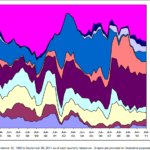Utility companies are back in the headlines as investors reconsider their preference for dividend-paying equities with uncertain tax policy coming in 2012. Key utility sector indexes are off more than 6% in the last month while forward yields look compelling for conservative investors.
Tax Concerns are Overblown
Investors traditionally value utilities on a dividend discount model which makes stock prices a function of after-tax dividend distributions. Naturally, Washington DC’s recent discussion about higher capital gains and dividend taxes lead to modest profit-taking and tax strategy shifts ahead of 2013.
In the long-run, though, the warnings about dividend taxes may be overblown. In the short-term, higher capital gains taxes will lead to a simple shift in investor interest. Institutional investors which manage capital in taxable accounts will likely flee utilities if higher dividend taxes become a political reality. Bingo-playing seniors looking for attractive returns on investment capital from tax-deferred investment vehicles will find ample reason to hold utilities for their routine and predictable distributions.
Relative to corporate bond yields, utilities are undervalued. Dividend yields in utility companies are on par with investment grade corporate debt yields. This goes against historical norms – utility yields usually came at a discount to corporate debt yields.
After taxes, $1 in dividends is the same as $1 in corporate debt coupons when both are held in retirement accounts. Income investors should see these investments to be on par with one another. Tax policy is unimportant to realistic utility valuations.
Why Utility ETFs Win Out
Utilities are a vastly different investment than other high yield opportunities. First, many of the best dividend payers are in the regulated utility industry, meaning their returns on capital are guaranteed and their customers are entirely captive. Compared to junk bond ETFs, which place investors in the most speculative corner of high-yield investing, utilities provide similar yields with much more creditworthiness.
Furthermore, utilities offer inflation protection. While higher inflation rates leads to lower utility company valuations, utilities are paid based on how much capital they deploy in regulated markets. Therefore, inflation in the cost to build new power plants means more capital at work and more capital earning a guaranteed return for regulated utility investors.
All in, utilities are a great investment for investors who want yields and safety of principal. Utilities aren’t an investment for those who expect market beating returns – those who rightfully concern themselves with future capital gains tax increases.  Aside from utilities and their respective ETFs potentially offering a buying opportunity on the dip, other high yielding ETF categories include mortgage REITs, Preferreds, Dividend Dogs, and MLP issues, which have been broadly beaten down in recent weeks.
Top 3 Utility ETFs
Investors have three excellent choices in the utility space:
- Utilities Select Sector SPDR (XLU) – This market cap weighted ETF from State Street provides investors a mechanism to track 32 individual utility companies, energy producers, and traders. With an annual expense ratio of .18% per year and yields of 4.2% per year, this fund is a great way to play the broad utility sector.
- Vanguard Utilities ETF (VPU) – Vanguard reputation of forcing diversification is apparent in its utilities ETF VPU, which holds investments in 78 companies spanning from small to large cap stocks. Market cap weighted and invested in utilities of all types (electric, gas, and water companies as well as distributors), the fund spins off a current yield of 3.9% with the most diversified exposure of any utilities index. An expense ratio of .19% is more than fair for so much diversification.
- Dow Jones U.S. Utilities Index Fund (IDU) – Tracking the best known of all the utilities indexes, the fund follows the market cap weighting system of its peers while investing in 67 different companies. With a yield of 3.2%, it’s the lowest yielding fund of them all. A combination of lower yields and higher fund expenses (expenses total .48% per year) will likely weigh on this fund in the long haul.
Vanguard’s diverse holdings, moderate yield, and low annual expense ratio make it a top pick for investors looking for a simple play on an industry that can stand the test of time and tax policy to deliver strong consistent yields. Capital gains taxation is hardly a reason for income investors to ditch dividends.
Disclosure: No position in any tickers mentioned here.











{ 0 comments… add one now }